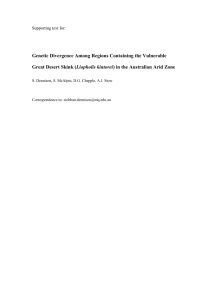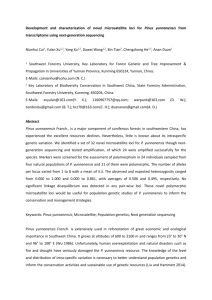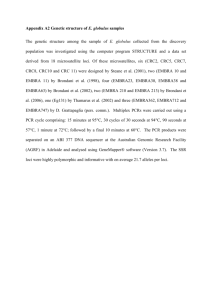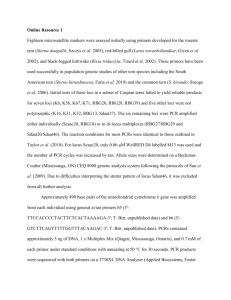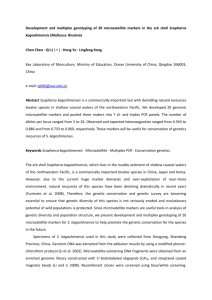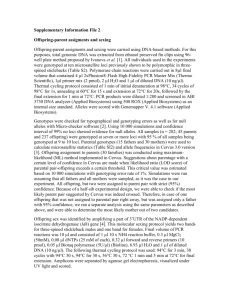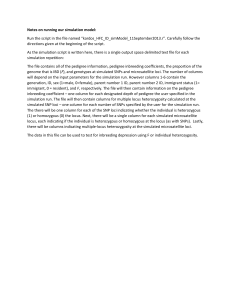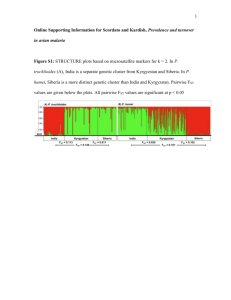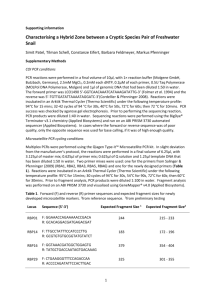Supplementary methods Microsatellite genotyping methods Kiwi
advertisement
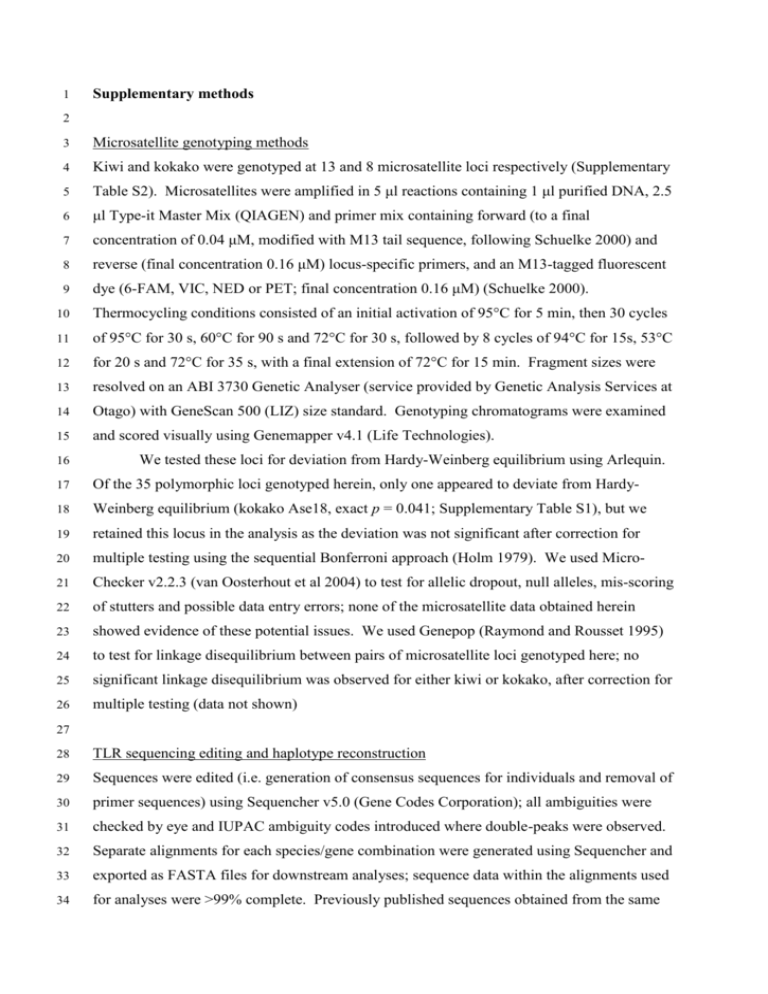
1 Supplementary methods 2 3 Microsatellite genotyping methods 4 Kiwi and kokako were genotyped at 13 and 8 microsatellite loci respectively (Supplementary 5 Table S2). Microsatellites were amplified in 5 μl reactions containing 1 μl purified DNA, 2.5 6 μl Type-it Master Mix (QIAGEN) and primer mix containing forward (to a final 7 concentration of 0.04 μM, modified with M13 tail sequence, following Schuelke 2000) and 8 reverse (final concentration 0.16 μM) locus-specific primers, and an M13-tagged fluorescent 9 dye (6-FAM, VIC, NED or PET; final concentration 0.16 μM) (Schuelke 2000). 10 Thermocycling conditions consisted of an initial activation of 95°C for 5 min, then 30 cycles 11 of 95°C for 30 s, 60°C for 90 s and 72°C for 30 s, followed by 8 cycles of 94°C for 15s, 53°C 12 for 20 s and 72°C for 35 s, with a final extension of 72°C for 15 min. Fragment sizes were 13 resolved on an ABI 3730 Genetic Analyser (service provided by Genetic Analysis Services at 14 Otago) with GeneScan 500 (LIZ) size standard. Genotyping chromatograms were examined 15 and scored visually using Genemapper v4.1 (Life Technologies). 16 We tested these loci for deviation from Hardy-Weinberg equilibrium using Arlequin. 17 Of the 35 polymorphic loci genotyped herein, only one appeared to deviate from Hardy- 18 Weinberg equilibrium (kokako Ase18, exact p = 0.041; Supplementary Table S1), but we 19 retained this locus in the analysis as the deviation was not significant after correction for 20 multiple testing using the sequential Bonferroni approach (Holm 1979). We used Micro- 21 Checker v2.2.3 (van Oosterhout et al 2004) to test for allelic dropout, null alleles, mis-scoring 22 of stutters and possible data entry errors; none of the microsatellite data obtained herein 23 showed evidence of these potential issues. We used Genepop (Raymond and Rousset 1995) 24 to test for linkage disequilibrium between pairs of microsatellite loci genotyped here; no 25 significant linkage disequilibrium was observed for either kiwi or kokako, after correction for 26 multiple testing (data not shown) 27 28 TLR sequencing editing and haplotype reconstruction 29 Sequences were edited (i.e. generation of consensus sequences for individuals and removal of 30 primer sequences) using Sequencher v5.0 (Gene Codes Corporation); all ambiguities were 31 checked by eye and IUPAC ambiguity codes introduced where double-peaks were observed. 32 Separate alignments for each species/gene combination were generated using Sequencher and 33 exported as FASTA files for downstream analyses; sequence data within the alignments used 34 for analyses were >99% complete. Previously published sequences obtained from the same 35 primers and study populations (Grueber and Jamieson 2013) were also included in the 36 alignments. None of the regions we sequenced contained stop-codons or frame-shift 37 variation. 38 For each locus in each population, we used PHASE v2.1.1 (Stephens et al 2001; 39 Stephens and Donnelly 2003) implemented in DNAsp v5.1 (Librado and Rozas 2009) to infer 40 haplotypes within each population. PHASE was run using the following settings: number of 41 iterations = 1,000; thinning interval = 10; burn-in iterations = 1,000; recombination model = 42 MS (no recombination) due to the relatively small sample sizes. Haplotypes were assigned 1- 43 letter codes and used as genotype data for calculating heterozygosity. 44 45 MCMC model specification and diagnostics 46 All MCMC models were run for 7×106 iterations, with a burnin period of 2.5×106 iterations 47 and a thinning interval of 4,500 iterations, thus providing us with 1,000 samples of the 48 posterior distribution of each parameter estimated by the model. Statistical significance is 49 inferred when the 95% credible interval (CI; as produced by MCMCglmm) of these 50 distributions does not cross zero. Models were observed to have converged by running three 51 independent MCMC chains and assessing the results thereof using Gelman-Rubin 52 diagnostics; all analyses produced estimates of the potential scale reduction factor < 1.1 53 (Gelman and Rubin 1992). Within-chain mixing was assessed using the autocor function in 54 MCMCglmm; all results come from chains with an autocorrelation < 0.1 between subsequent 55 lags; we report parameter estimates from the chain with the lowest deviance information 56 criterion (DIC). All presented results come from models fitting an inverse gamma prior 57 (specified in MCMCglmm as V = diag(2), nu = 0.002; where V is an estimate of variance 58 associated with model variance components, and nu is the degree-of-belief parameter for that 59 variance) for random factors and the default prior for fixed effects. The sensitivity of the 60 models results to prior specification was checked by repeating the analysis with a parameter 61 expanded prior for all random effects (as described in Hadfield 2010). Models with both 62 priors produced qualitatively identical results (data not shown). 63 Supplementary Table S1 Microsatellite loci genotyped in this study, with number of 64 individuals (N), number of alleles (A), observed and expected heterozygosity (HO and HE, 65 respectively) and P-value from Hardy-Weinberg exact test. Species Locus N A HO HEa P-value Reference Kiwi Apt29 22 5 0.818 0.733 0.156 (Shepherd and Lambert 2006) Apt37 22 3 0.136 0.132 1.000 (Shepherd and Lambert 2006) Apt59 22 6 0.864 0.796 0.243 (Shepherd and Lambert 2006) Apt68 22 3 0.591 0.534 0.670 (Shepherd and Lambert 2006) Aptowe3 22 3 0.364 0.551 0.156 (Ramstad et al 2010) Aptowe8 19 8 0.789 0.782 0.611 (Ramstad et al 2010) Aptowe24 22 3 0.591 0.606 1.000 (Ramstad et al 2010) Aptowe28 22 4 0.682 0.557 0.713 (Ramstad et al 2010) KMS1 22 2 0.136 0.130 1.000 (Jensen et al 2008) KMS7R 22 3 0.136 0.132 1.000 (Jensen et al 2008) KMS14B 21 3 0.529 0.542 1.000 (Jensen et al 2008) KMS30 22 4 0.273 0.360 0.141 (Jensen et al 2008) KMS74B 22 2 0.500 0.460 1.000 (Jensen et al 2008) Ase18 21 6 0.429 0.481 0.048 * (Richardson et al 2000) HrU6 21 7 0.857 0.823 0.771 (Primmer et al 1995) K3/K4 21 9 0.714 0.775 0.125 (Hudson et al 2000) K11/K12 21 3 0.571 0.668 0.034 * (Hudson et al 2000) Pca01 21 2 0.333 0.285 1.000 (Lambert et al 2005) Pca07 21 9 0.857 0.819 0.541 (Lambert et al 2005) Pca08 21 3 0.190 0.180 1.000 (Lambert et al 2005) Pca13 20 3 0.450 0.574 0.335 (Lambert et al 2005) Kokako 66 a adjusted for sample size using Levene’s correction (Levene 1949) 67 * statistically significant at α = 0.05 68 69 Supplementary Table S2 Observed and expected heterozygosity (HO and HE, respectively) 70 of polymorphic TLR loci in population samples of 10 threatened New Zealand birds. Also 71 shown is the P-value for deviation from Hardy-Weinberg equilibrium (exact test). Locus Species TLR1LA Kiwi TLR3 TLR4 TLR5 HO HE P-value 18 0.111 0.108 1.000 Kakapo 17 0.176 0.166 1.000 Kakariki 18 0.778 0.787 0.859 Rock wren 21 0.952 0.902 0.858 Mohua 21 0.476 0.587 0.243 Robin 22 0.500 0.613 0.205 Hihi 19 0.947 0.740 0.000 * Kokako 21 0.333 0.575 0.050 Saddleback 20 0.400 0.581 0.242 TLR1LB Kakariki TLR2B N 20 0.800 0.765 0.997 Rock wren 22 0.682 0.885 0.069 Mohua 21 0.524 0.682 0.257 Hihi 20 0.250 0.273 0.228 Robin 19 0.737 0.797 0.122 Kokako 23 0.087 0.162 0.132 Kiwi 20 1.000 0.755 0.007 * Robin 24 0.542 0.530 0.253 Kiwi 20 0.200 0.188 1.000 Rock wren 21 0.524 0.556 0.430 Mohua 23 0.522 0.394 0.269 Robin 20 0.300 0.354 0.326 Kokako 19 0.053 0.053 1.000 Takahe 19 0.158 0.149 1.000 Kakariki 20 0.750 0.801 0.266 Rock wren 21 0.714 0.774 0.317 Mohua 24 0.667 0.664 0.304 Robin 23 0.652 0.756 0.437 Kiwi 19 0.158 0.235 0.259 Kakariki 20 0.750 0.678 0.804 TLR7 TLR15 TLR21 Mohua 20 0.800 0.751 1.000 Robin 19 0.579 0.579 0.569 Kokako 24 0.833 0.867 0.078 Kiwi 20 0.450 0.450 1.000 Kakariki 18 0.556 0.457 0.598 Takahe 20 0.750 0.481 0.015 * Mohua 21 0.762 0.743 0.135 Robin 19 0.737 0.683 0.092 Hihi 18 0.611 0.475 0.320 Kokako 21 0.905 0.833 0.824 Hihi 19 0.421 0.408 0.551 Robin 22 0.500 0.702 0.025 * 72 * indicates statistically significant deviation from Hardy-Weinberg equilibrium at α = 0.05; none remained 73 significant at α = 0.05 after accounting for multiple comparisons. 74 75 Supplementary Table S3 Haplotype-frequency based tests of neutrality for species with ≥ 2 76 toll-like receptor genes with ≥ 5 haplotypes (h). P-values (deviation from neutrality) are 77 based on 1,000 permutations of the data (using Arlequin). Species Locus N h Kakariki TLR1LA 18 TLR1LB Rock wren Robin Kokako 78 Tajima’s D Ewens-Watterson test statistic P-value statistic P-value 8 0.817 0.823 0.235 0.462 20 6 1.176 0.902 0.254 0.143 TLR4 20 7 0.776 0.824 0.219 0.167 TLR5 20 8 0.771 0.810 0.339 0.850 TLR1LA 21 13 0.538 0.755 0.119 0.170 TLR1LB 22 16 -0.235 0.465 0.135 0.808 TLR3 21 6 -1.005 0.185 0.457 0.829 TLR4 21 8 0.028 0.570 0.245 0.443 TLR1LA 22 7 -0.646 0.340 0.401 0.824 TLR1LB 19 7 1.043 0.854 0.224 0.208 TLR2B 24 6 0.003 0.581 0.481 0.759 TLR4 23 8 0.340 0.696 0.261 0.528 TLR15 19 8 -0.630 0.292 0.335 0.854 TLR21 22 5 1.285 0.900 0.314 0.195 TLR5 24 8 0.571 0.747 0.151 0.004 * TLR15 21 14 -1.255 0.089 0.187 0.919 * indicates statistically significant deviation from neutral expectation at α = 0.05. 79 Supplementary Table S4 Effect of TLR ligand type (viral or non-viral) on levels of diversity in wild birds. In all models “non-viral” was the 80 reference category – negative effect sizes for “Viral” indicate that viral TLRs had lower diversity. “Species” was entered in each model as a 81 random factor. Response variable GLMM error structure Intercept (SE) Viral (β, SE) ΔAIC versus null model h – number of haplotypes Poisson 1.608 (0.158) -0.582 (0.198) * -7.8 k – mean nucleotide differences among haplotypes Gaussiana -0.089 (0.276) -0.939 (0.340) * -4.5 π – nucleotide diversity Gaussianb -6.976 (0.300) -0.725 (0.348) * -1.8 Number of SNPs – total Poisson 1.500 (0.235) -0.902 (0.222) * -18.8 Number of SNPs – non-synonymous Poisson 0.965 (0.168) -0.571 (0.281) * -2.7 Number of SNPs – synonymous Poisson 0.785 (0.290) -1.323 (0.369) * -16.8 82 a the response variable is count-based, so it was normalised by log transformation 83 b the response variable is proportion-based, so it was normalised by logit transformation 84 * indicates the 95% confidence interval for the effect size excludes zero (significantly lower diversity in the “viral” group at α = 0.05) 85 86 Supplementary Fig. S1 Genetic diversity of TLRs proposed to bind viral ligands (“Viral 87 TLRs”: TLR3, TLR7, TLR21) versus those proposed to bind proteinaceous ligands (“Nonviral 88 TLRs”: TLR1LA, TLR1LB, TLR2A, TLR2B, TLR4, TLR5, TLR15) (Keestra et al 2013). Four 89 measures of diversity are presented: (a) total number of SNPs, (b) number of haplotypes h, 90 (c) nucleotide diversity π and (d) haplotype diversity k. Two data-points are joined by a line 91 if they are derived from the same species; where species were sequenced at > 1 TLR locus in 92 either category, these data were averaged for the figure (all loci were treated separately in 93 statistical analysis, see Methods). 94 95 96 Supplementary Fig. S2 Relationship between number of microsatellite loci used (a), or their 97 diversity in terms of either mean gene diversity (b) or mean number of alleles (c), and the 98 magnitude of error surrounding the slope estimate for microsatellite MLH and TLR 99 heterozygosity (width of the 95% CI) in each of the 10 species (i.e. N = 10 in each panel). 100 See also Table 2 (microsatellite summary data) and Figure 2 (model slopes summary data). 101 Literature cited in supplementary material 102 Gelman A, Rubin DB (1992) Inference from iterative simulation using multiple sequences. Stat Sci 7:457–472. 103 104 105 Grueber CE, Jamieson IG (2013) Primers for amplification of innate immunity Toll-like receptors in threatened birds of the Apterygiformes, Gruiformes, Psittaciformes and Passeriformes. Conserv Genet Resour 5:1043–1047. doi: 10.1007/s12686-013-9965-x 106 107 Hadfield JD (2010) MCMCglmm course notes. See http://cran.rproject.org/web/packages/MCMCglmm/vignettes/CourseNotes.pdf. 108 Holm S (1979) A simple sequentially rejective multiple test procedure. Scandanavian J Stat 6:65–70. 109 110 Hudson QJ, Wilkins JR, Waas JR, Hogg ID (2000) Low genetic vairability in small populations of New Zealand kokako Callaeas cinera wilsoni. Biol Conserv 96:105–112. 111 112 Jensen T, Nutt KJ, Seal BS, et al (2008) Isolation and characterization of microsatellite loci in the North Island brown kiwi, Apteryx mantelli. Mol Ecol Resour 8:399–401. doi: 10.1111/j.1471-8286.2007.01970.x 113 114 Keestra AM, de Zoete MR, Bouwman LI, et al (2013) Unique features of chicken Toll-like receptors. Dev Comp Immunol 41:316–323. doi: 10.1016/j.dci.2013.04.009 115 116 117 Lambert DM, King T, Shepherd LD, et al (2005) Serial population bottlenecks and genetic variation: translocated populations of the New Zealand saddleback (Philesturnus carunculatus rufusater). Conserv Genet 6:1–14. 118 119 Levene H (1949) On a Matching Problem Arising in Genetics. Ann Math Stat 20:91–94. doi: 10.1214/aoms/1177730093 120 121 Librado P, Rozas J (2009) DnaSP v5: a software for comprehensive analysis of DNA polymorphism data. Bioinformatics 25:1451–1452. doi: 10.1093/bioinformatics/btp187 122 123 124 Primmer CR, Møller AP, Ellegren H (1995) Resolving genetic relationships with microsatellite markers: a parentage testing system for the swallow Hirundo rustica. Mol Ecol 4:493–498. doi: 10.1111/j.1365294X.1995.tb00243.x 125 126 127 Ramstad KM, Pfunder M, Robertson HA, et al (2010) Fourteen microsatellite loci cross-amplify in all five kiwi species (Apteryx spp.) and reveal extremely low genetic variation in little spotted kiwi (A. owenii). Conserv Genet Resour 2:333–336. doi: 10.1007/s12686-010-9233-2 128 129 Raymond M, Rousset F (1995) GENEPOP (version 1.2): population genetics software for exact tests and ecumenicism. J Hered 86:248–249. 130 131 132 Richardson DS, Jury FL, Dawson DA, et al (2000) Fifty Seychelles warbler (Acrocephalus sechellensis) microsatellite loci polymorphic in Sylviidae species and their cross-species amplification in other passerine birds. Mol Ecol 9:2225–2230. doi: 10.1046/j.1365-294X.2000.105338.x 133 134 Schuelke M (2000) An economic method for the fluorescent labeling of PCR fragments. Nat Biotechnol 18:233–234. 135 136 Shepherd LD, Lambert DM (2006) Nuclear microsatellite DNA markers for New Zealand kiwi (Apteryx spp.). Mol Ecol Notes 6:227–229. doi: 10.1111/j.1471-8286.2005.01201.x 137 138 Stephens M, Donnelly P (2003) A comparison of bayesian methods for haplotype reconstruction from population genotype data. Am J Hum Genet 73:1162–1169. 139 140 Stephens M, Smith NJ, Donnelly P (2001) A new statistical method for haplotype reconstruction from population data. Am J Hum Genet 68:978–989. 141 142 143 Van Oosterhout C, Hutchinson WF, Wills DPM, Shipley PF (2004) Micro-Checker: software for identifying and correcting genotyping errors in microsatellite data. Mol Ecol Notes 4:535–538.
